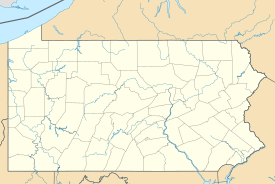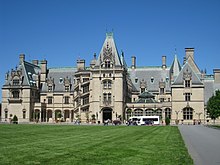Woodmont, Pennsylvania
| Woodmont, Pennsylvania | ||
|---|---|---|
| National Register of Historic Places | ||
| National Historic Landmark | ||
|
The south-facing front facade (2017) |
||
|
|
||
| location | Gladwyne , Montgomery County , Pennsylvania | |
| Coordinates | 40 ° 4 ′ 3 ″ N , 75 ° 17 ′ 39 ″ W | |
| surface | 29.5 hectares | |
| Built | 1892-95 | |
| architect | William L. Price | |
| Architectural style | Neo-renaissance | |
| NRHP number | 98001192 | |
| Data | ||
| The NRHP added | August 5, 1998 | |
| Declared as an NHL | August 5, 1998 | |
Woodmont is a historic stately home in Gladwyne , Montgomery County , Pennsylvania . It is a National Historic Landmark and the seat of Father Divine's Peace Mission Movement .
Building history
Woodmont, which is strongly reminiscent of the castles of the Loire , was built in the neo-Renaissance style from slate and limestone and the roof was covered with tiles and copper plates. The associated estate is almost 30 hectares in size. Woodmont's architect was William L. Price . Price made the designs for Woodmont in the winter of 1892, after which construction began in the spring of 1893 and was completed after two years. Price later became one of the most important architects of the American Arts and Crafts Movement . Woodmont was built for the industrialist and politician Alan Wood , who came from a Quaker family from Philadelphia. The model for Woodmont was the Wood and Price Biltmore Estate , the property for George Washington Vanderbilt II , which had been under construction since 1889. In contrast to Biltmore Estate and comparable properties of other large industrialists of the time, Woodmont was built within sight of its source of income by having the ironworks of the Alan Wood Iron and Steel Company on a hill in view. Wood lived in Woodmont until his death and sold the property to his nephew Richard G. Wood a year before he died. He lived there until 1931. After that, the lawyer J. Hector McNeal bought the main building, while a large part of the property was sold to the Philadelphia Golf Club.
Peace Mission Movement
Woodmont has been owned by the Peace Mission Movement, a religious movement founded by Father Divine , since 1952 . The African American Divine was born under the name George Baker in Maryland in 1879 , preached in the southern states from 1912 and was able to win an ever larger, mostly black following as a religious leader, some of whom revered him as the new Messiah . He later formed a commune in Sayville , New York , which gave birth to the Peace Mission Movement, and called himself Father Divine. With the onset of the Great Depression, his movement received more and more support, including by whites, and the first offshoots were founded in Harlem and Newark . The Peace Mission Movement was worldly oriented, social and labor programs, joint one of the first congregations worship of whites and African Americans had and was known to it vigorously for an end to racial segregation began, making it a forerunner of the American civil rights movement applies . By the mid-1930s, the Peace Mission Movement had grown into a mass movement with enormous business fortunes, fed by donations, volunteer work, cheap hotels, restaurants, clothing stores, and other businesses. After losing a former follower on trial for embezzlement, Divine moved to Philadelphia in 1942. During this time, the focus of the Peace Mission Movement moved away from a mass movement towards establishing itself as a religious institution, especially since the number of followers fell with the economic upturn. In 1953, when Father Divine moved into Woodmont, he referred to the property as "the foundation for the house of God". In the years 1966-70 a tomb for Father Divine was erected on the property, which was designed by the sculptor Donald De Lue . It consists of a crypt clad with red marble.
Woodmont became a National Historic Landmark on August 5, 1998 and is listed on the National Register of Historic Places . In addition to the main building, six other structures count as contributing properties .
Web links
Remarks
- ^ Susan Glassman, Woodmont: National Historic Landmark Nomination . In: National Register of Historic Places database . National Park Service , January 14, 1998, accessed August 19, 2017 (294 KB), p. 19.
- ^ Susan Glassman, Woodmont: National Historic Landmark Nomination . In: National Register of Historic Places database . National Park Service , January 14, 1998, accessed August 19, 2017 (294 KB), p. 3.
- ^ Susan Glassman, Woodmont: National Historic Landmark Nomination . In: National Register of Historic Places database . National Park Service , January 14, 1998, accessed August 19, 2017 (294 KB), p. 4.
- ^ Susan Glassman, Woodmont: National Historic Landmark Nomination . In: National Register of Historic Places database . National Park Service , January 14, 1998, accessed August 19, 2017 (294 KB), pp. 5, 6.
- ^ A b Susan Glassman: Woodmont: National Historic Landmark Nomination . In: National Register of Historic Places database . National Park Service , January 14, 1998, accessed August 19, 2017 (294 KB), p. 14.
- ^ A b Susan Glassman: Woodmont: National Historic Landmark Nomination . In: National Register of Historic Places database . National Park Service , January 14, 1998, accessed August 19, 2017 (294 KB), p. 12.
- ^ Susan Glassman, Woodmont: National Historic Landmark Nomination . In: National Register of Historic Places database . National Park Service , January 14, 1998, accessed August 19, 2017 (294 KB), p. 16.
- ^ Susan Glassman, Woodmont: National Historic Landmark Nomination . In: National Register of Historic Places database . National Park Service , January 14, 1998, accessed August 19, 2017 (294 KB), p. 8.
- ^ A b Susan Glassman: Woodmont: National Historic Landmark Nomination . In: National Register of Historic Places database . National Park Service , January 14, 1998, accessed August 19, 2017 (294 KB), p. 17.
- ^ Robert Weisbrot: Father Divine's Peace Mission Movement. In Timothy Miller (Ed.): America's Alternative Religions. State University of New York Press, Albany 1995, ISBN 0-7914-2397-2 , pp. 286-288 .
- ^ Robert Weisbrot: Father Divine's Peace Mission Movement. In Timothy Miller (Ed.): America's Alternative Religions. State University of New York Press, Albany 1995, ISBN 0-7914-2397-2 , p. 288 .
- ↑ Woodmont in the National Register Information System. National Park Service , accessed August 19, 2017.
- ↑ Listing of National Historic Landmarks by State: Pennsylvania . National Park Service , accessed August 19, 2017.
- ^ Susan Glassman, Woodmont: National Historic Landmark Nomination . In: National Register of Historic Places database . National Park Service , January 14, 1998, accessed August 19, 2017 (294 KB), p. 10.


